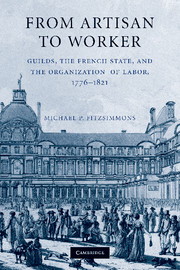2 - The New Regime Begins, 1792–1799
Published online by Cambridge University Press: 06 July 2010
Summary
It is a prejudice of the old regime, which has found partisans even under the new, that the perfection of mechanization and the simplification of hand work are dangerous in that they deprive many workers of a means of existence.
La Décade philosophique, littéraire et politique, par une société de républicains, 10 brumaire an IIIAs David Andress observed, “unlicensed, free-for-all competition was the terror of the economic Old Regime, and the whole guild system functioned to keep it at bay.” The measures enacted by the National Assembly meant that the well-ordered, hierarchical world of corporations and commerce had been recast into an unregulated, egalitarian system based on occupational licenses.
More broadly, guilds had performed numerous functions, from guaranteeing the quality of bread and meat to assuring the technical competence of workers. It had not been the intention of the National Assembly to end oversight altogether and the d'Allarde law had not sought to do away with regulation of trades – its objective had been only to end guild administration. The subsequent abolition of all inspectorates, only days before the Assembly disbanded, inadvertently created confusion and disorder.
The Assembly had proceeded along a path of debate and experiment and acted on the basis of political and constitutional objectives rather than economic ones. This contingent, discrete approach meant that the Assembly did not implement, or even consider, a comprehensive alternative program when it abolished guilds, which induced the disarray that followed.
- Type
- Chapter
- Information
- From Artisan to WorkerGuilds, the French State, and the Organization of Labor, 1776–1821, pp. 58 - 120Publisher: Cambridge University PressPrint publication year: 2010



